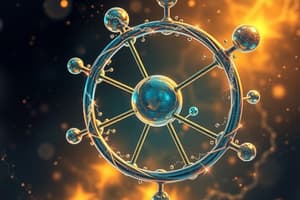Podcast
Questions and Answers
What type of bond involves the transfer of electrons between a metal and a non-metal?
What type of bond involves the transfer of electrons between a metal and a non-metal?
- Hydrogen bond
- Ionic bond (correct)
- Metallic bond
- Covalent bond
In a covalent bond, how many atoms are involved?
In a covalent bond, how many atoms are involved?
- Four
- Three
- Two (correct)
- One
What does electronegativity measure in an atom?
What does electronegativity measure in an atom?
- Tendency to form bonds
- Ability to attract photons
- Ability to draw shared electrons towards itself in a bond (correct)
- Rate of electron loss
What happens when atoms with different electronegativities are involved in a covalent bond?
What happens when atoms with different electronegativities are involved in a covalent bond?
Why does the electron cloud move towards the more electronegative atom in a covalent bond?
Why does the electron cloud move towards the more electronegative atom in a covalent bond?
Which intermolecular force explains the temporary attraction between atoms due to the formation of spontaneous dipoles?
Which intermolecular force explains the temporary attraction between atoms due to the formation of spontaneous dipoles?
What type of molecule is methane considered to be?
What type of molecule is methane considered to be?
In ammonia molecule, why does it exhibit a net dipole?
In ammonia molecule, why does it exhibit a net dipole?
What characteristic makes a molecule polar?
What characteristic makes a molecule polar?
Why is carbon tetrachloride considered non-polar?
Why is carbon tetrachloride considered non-polar?
Which step is crucial in determining the dipole moment of a molecule?
Which step is crucial in determining the dipole moment of a molecule?
What property of the water molecule makes it polar?
What property of the water molecule makes it polar?
In a carbon tetrachloride molecule, why do the dipoles cancel out each other?
In a carbon tetrachloride molecule, why do the dipoles cancel out each other?
Why does carbon dioxide have a zero dipole moment?
Why does carbon dioxide have a zero dipole moment?
What occurs when the polar bonds in a molecule cancel each other out?
What occurs when the polar bonds in a molecule cancel each other out?
Flashcards are hidden until you start studying




